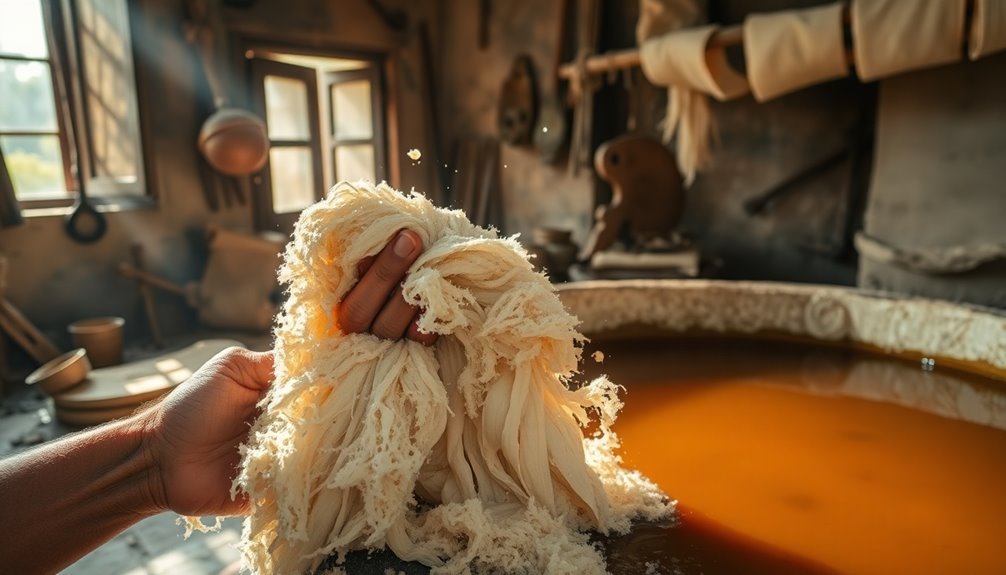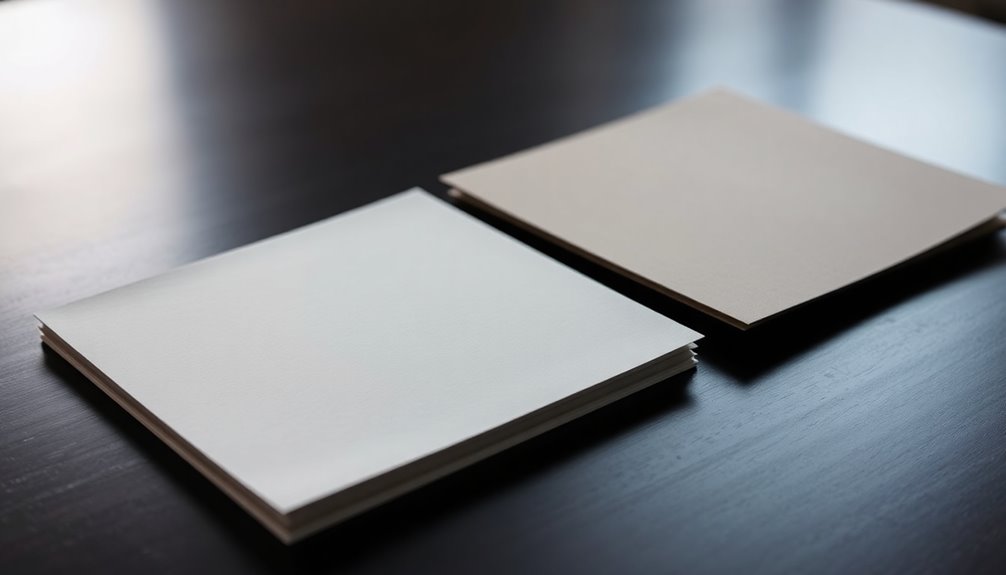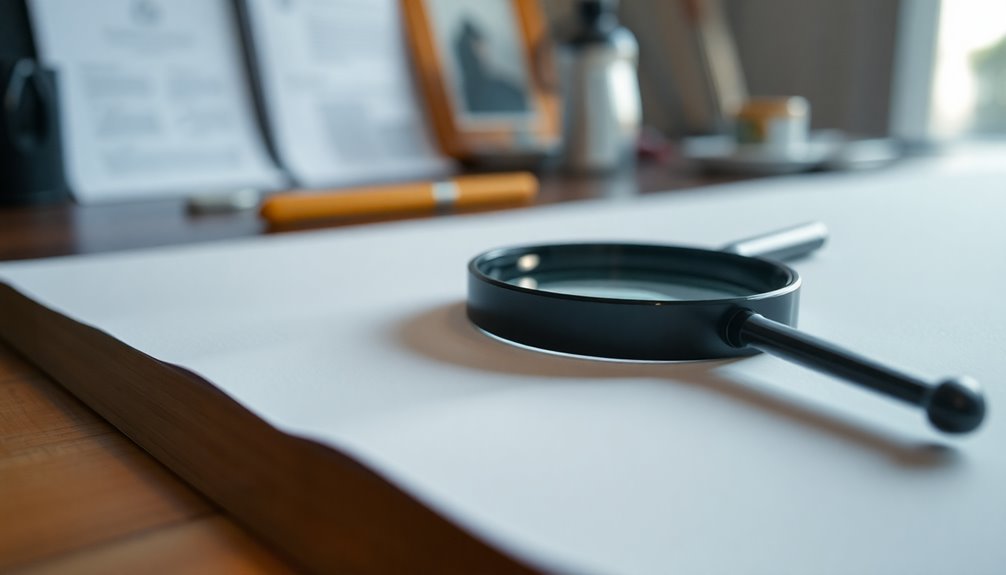You're about to uncover the fascinating story behind the paper-making dynasty that changed the course of history. This legacy originates from ancient China, where Cai Lun introduced innovations around 105 AD. His techniques transformed bamboo strips and silk into lightweight, affordable paper, enhancing literacy and communication across the empire. You'll discover how this invention laid the groundwork for mass production and influenced cultures worldwide. Plus, modern eco-friendly alternatives show the enduring impact of paper on our environment. There's so much more to this captivating tale that awaits you, revealing the hidden significance of paper through the ages.
Key Takeaways
- Cai Lun's invention of paper in 105 AD transformed communication and record-keeping in the Han Dynasty, with lasting cultural impacts.
- The shift from bamboo strips and silk to affordable paper increased literacy throughout the Chinese empire, fostering cultural advancements.
- Early paper-making techniques involved soaking, pounding, and drying plant fibers, showcasing a practical approach to writing materials.
- Innovations in paper production laid the groundwork for future mass production techniques, influencing writing practices worldwide.
- Sustainable alternatives to wood pulp paper, such as hemp and recycled materials, highlight the ongoing evolution of paper-making practices.
Ancient Innovations in Paper-Making
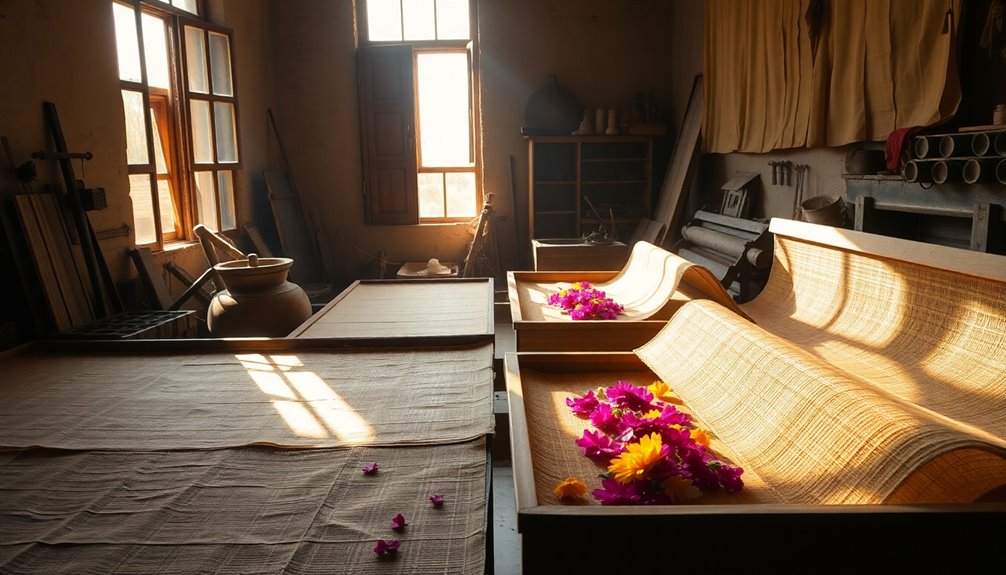
The ingenuity of ancient innovations in paper-making transformed communication and record-keeping in profound ways. You might not realize that this pivotal shift began with Cai Lun during the Han Dynasty around 105 AD. He introduced techniques that utilized plant fibers like hemp and mulberry bark, which were soaked, pounded, and dried on bamboo frames. This method created sheets that were perfect for writing and significantly improved upon earlier, cumbersome writing materials like bamboo strips and silk.
As paper became more affordable, it opened the door to broader literacy and documentation. Suddenly, more people could access this essential tool for communication, allowing ideas and knowledge to flourish. The quality and affordability of paper-making techniques caught the attention of Islamic cultures, which eagerly adopted this innovation. From there, it spread into Europe, changing the landscape of writing and record-keeping forever.
These ancient innovations didn't just improve paper; they laid the groundwork for a literate society that valued communication. As the demand for writing materials grew, so did the evolution of paper-making, ultimately leading to the mass production techniques we see today.
Chinese Invention of Paper

Cai Lun's innovation in paper-making marked a turning point in communication, significantly changing how information was recorded and shared. In around 105 A.D., during the Han Dynasty, Cai Lun developed a groundbreaking process using plant fibers, such as hemp and mulberry bark. Before this invention, the Chinese relied on cumbersome materials like bamboo strips and expensive silk for writing, which limited accessibility.
With Cai Lun's invention, paper emerged as a lighter and more affordable writing material, transforming record-keeping practices across the empire. This new medium enhanced communication, allowing for the swift exchange of ideas and information. As a result, literature flourished, and cultural advancements during the Han era surged, shaping intellectual thought for generations.
Moreover, paper's significance extended beyond China; it became a crucial export, influencing writing practices in various civilizations, including those in the Islamic world and eventually Europe. The ripple effects of Cai Lun's invention of paper fostered an interconnectedness among cultures, emphasizing its vital role in the evolution of communication and documentation throughout history.
Eco-Friendly Paper Alternatives
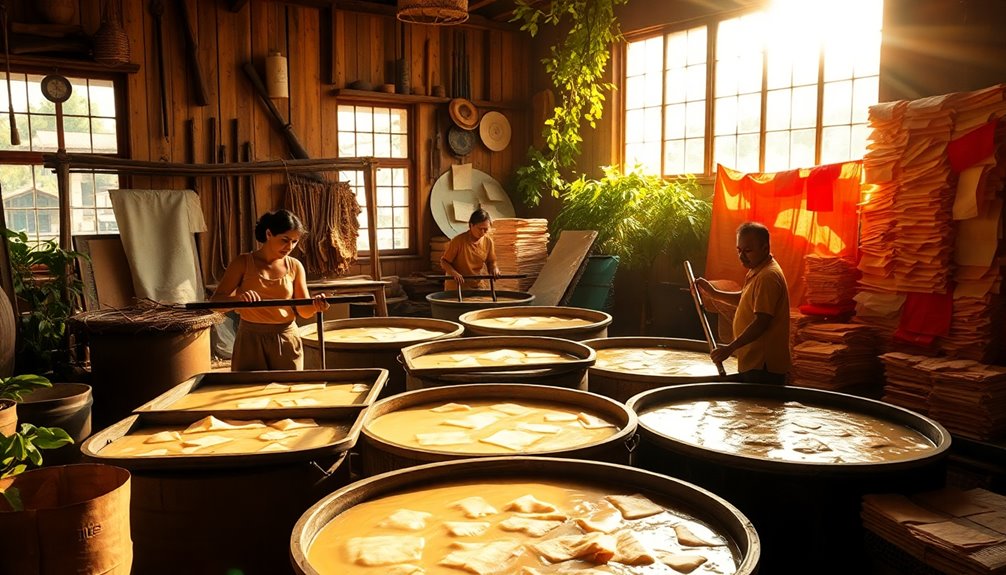
As awareness of environmental issues grows, eco-friendly paper alternatives are gaining traction as sustainable solutions for everyday use. You might consider options like hemp, which uses significantly less water and fewer chemicals compared to traditional wood pulp paper. Bamboo is another excellent choice; it grows rapidly and can be harvested without killing the plant, allowing for continuous regrowth and playing a vital role in reducing deforestation.
Recycled paper presents a straightforward alternative that significantly lowers the environmental impact of paper production. By utilizing existing paper products, it saves trees, water, and energy involved in creating new paper. Additionally, agricultural byproducts like rice straw and wheat straw can be transformed into paper, repurposing waste materials that would otherwise harm the environment.
Innovations in biodegradable options using plant fibers are also emerging, promising to reduce landfill waste and pollution. These alternatives not only provide eco-friendly paper solutions but also help create a more sustainable future. By opting for these alternatives, you contribute to a healthier planet and promote responsible consumption practices in your daily life.
Environmental Impact of Production

Producing paper has a significant environmental impact that can't be overlooked. The traditional paper-making process consumes vast amounts of water—between 10,000 to 20,000 gallons for just one ton. This intense water usage raises serious concerns about scarcity in many areas. Additionally, sourcing wood pulp contributes to deforestation, with around 13% of the world's forests being used for paper products, severely affecting biodiversity and carbon storage.
The chemical treatment of wood introduces harmful pollutants like dioxins and furans, which can leach into water sources, jeopardizing both human health and ecosystems. However, there's a silver lining: recycling paper can drastically reduce this environmental burden. It requires about 60% less energy and 70% less water than creating new paper from virgin fibers, leading to significant reductions in greenhouse gas emissions.
Shifting towards sustainable production practices is essential. Utilizing agricultural residues or certified sustainable wood sources can help minimize the ecological footprint of the paper industry. By making informed choices about paper use and supporting recycling, you can contribute to a healthier environment and protect our planet's precious resources.
Historical Paper Production Techniques
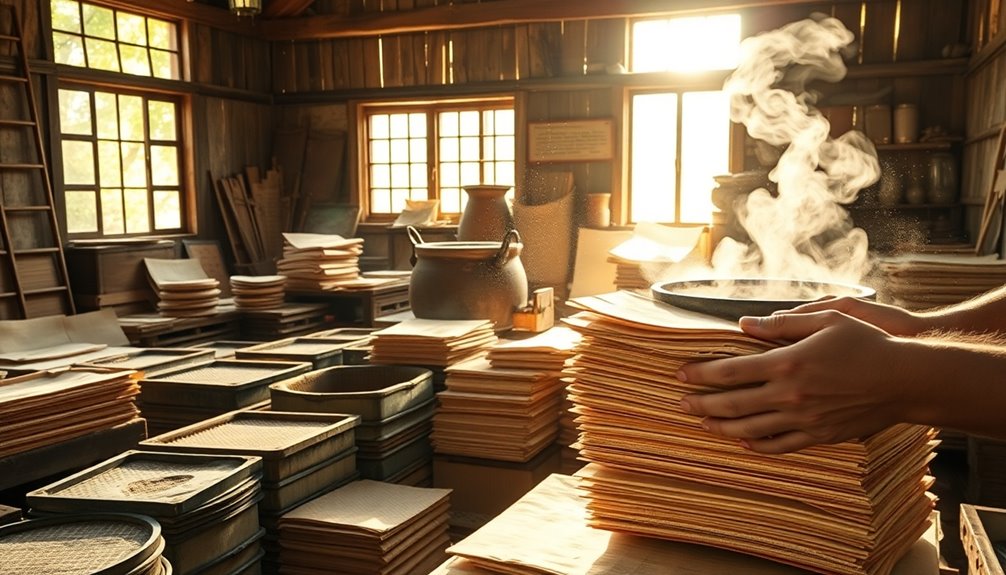
Understanding the environmental impact of modern paper production sheds light on the remarkable history of paper-making techniques. The invention of paper is credited to Cai Lun during the Han Dynasty around 105 AD. He utilized plant fibers like hemp and mulberry bark, transforming the way societies approached writing materials. Unlike the cumbersome bamboo strips and silk used before, this new paper-making process allowed for easier communication and record-keeping.
In ancient China, the traditional paper-making process involved soaking, pounding, and drying the raw materials on bamboo frames. This method created sheets that were not only practical but also held cultural significance. Early paper often featured a distinctive yellow dye, symbolizing imperial status and further emphasizing its importance in society.
Cultural Significance of Paper
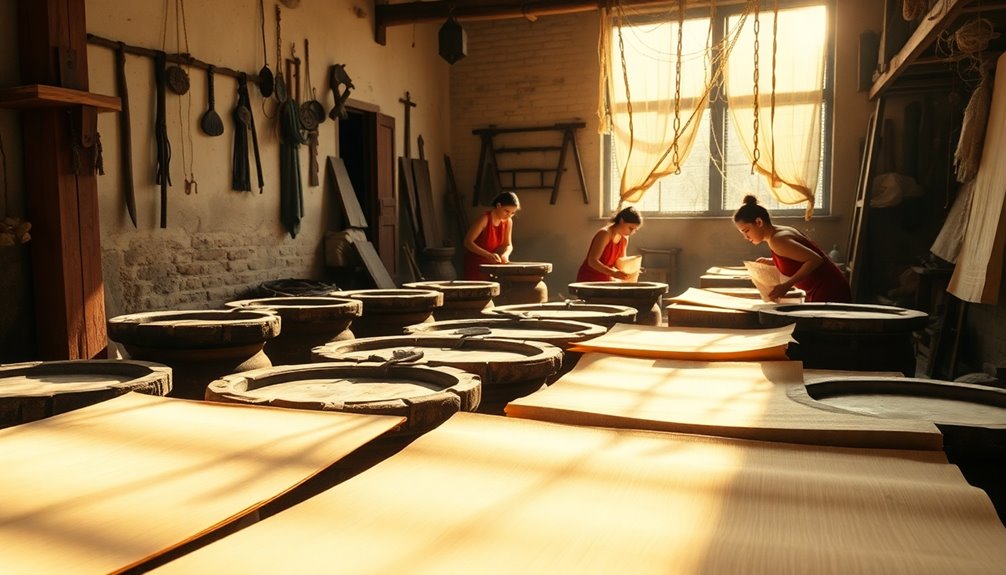
Throughout history, paper's cultural significance has evolved dramatically, shaping how societies communicate and preserve knowledge. The invention of paper during the Han Dynasty around 105 AD by Cai Lun revolutionized communication. This new writing material replaced cumbersome bamboo strips and silk, making it more accessible and practical for widespread use. As paper spread, it facilitated cultural exchange, impacting administration and literature not just in China but also in Islamic cultures.
The diffusion of technology allowed for advancements that laid the groundwork for the European Renaissance. Specialty papers emerged over time, catering to various artistic and commercial needs, further reflecting the evolving significance of writing materials.
The durability of paper contributed to its importance, enabling societies to create significant historical collections that preserved their legacies. By transitioning from fragile papyrus scrolls to more robust paper, cultures were able to maintain records and express ideas more effectively.
In essence, paper has been more than just a medium; it's been a bridge connecting civilizations, fostering creativity, and ensuring the continuity of knowledge through the ages. Its role in shaping cultural narratives is undeniable, making it a cornerstone of human civilization.
Frequently Asked Questions
Which Dynasty Was Responsible for Paper?
You might be surprised to learn that the Han Dynasty, around 105 AD, is credited with the invention of paper. Cai Lun, a court official, developed a more practical writing material by utilizing plant fibers like hemp and mulberry. This innovation replaced the cumbersome bamboo strips and silk previously used, making writing accessible. As paper gained popularity, it transformed communication and record-keeping, significantly impacting governance and trade in Chinese society.
What Was the First Paper Book in History?
The first paper book in history is the "Diamond Sutra," printed in China in 868 A.D. You'll find it fascinating that this Buddhist text uses woodblock printing techniques, showcasing the advanced technology of its time. The method involved carving the entire text onto a wooden block, inking it, and pressing paper to create multiple copies. You can appreciate how this innovative process paved the way for future printing developments and the spread of knowledge.
Did Paper Have an Impact on Other Civilizations?
Yes, paper's had a profound impact on other civilizations. It revolutionized record-keeping and communication, making information more accessible. As you explore the Silk Road's influence, you'll see how paper spread to Islamic cultures, enhancing administration and scholarship. In Europe, its arrival fueled the Renaissance, increasing literacy and allowing ideas to flourish. You'll notice how these advancements shaped journalism and scholarly work, connecting diverse cultures and transforming societies globally.
What Is the Story of Paper?
The story of paper begins with Cai Lun's innovation during the Han Dynasty around 105 AD. You'll see how this breakthrough changed communication forever. Instead of using bulky bamboo or expensive silk, people turned to accessible paper made from plant fibers. This new medium allowed knowledge to spread rapidly, making literature and education more widespread. Over centuries, paper-making techniques evolved, influencing pivotal historical moments like the Renaissance and the Reformation, shaping our world.

